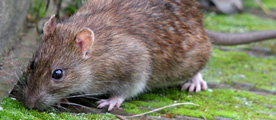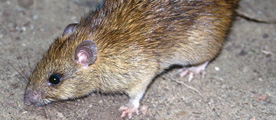Pest Info » Rats

Rattus norvegicus
(Norway rat or Brown rat)
The Norway rat can be found along the coast and riverbanks. They can also be found in basements and lower parts of any building.

Rattus rattus diardii
(House rat)
The house rat can be found indoors. They are very agile, aggressive, strong and can climb walls. Roof rats eat almost anythings but they prefer fruits, vege and cereal products. The rodent population can multiply very quickly in places like hawker centres, wet markets and even restaurants where food and water are plentiful.
Rats Control
Rats control are vital to your food-related business. Rats proliferate and get out of hand very quickly. They are well-known disease vectors. Their presence is often detected by the customers in a food establishment unknown to the operators. Customers keep quiet and do not make return visits. However, before long, the local health authorities will know about it.
Your business and reputation will be greatly affected. Therefore, even if the problem is not apparent to you, do call in our pest control experts who will be able to expose all their hiding places to you. Allow them to not only exterminate these pests but also teach you how to take preventive measures and maintain your premises in compliance with the regulations of the local health authorities and other standard food handling practices.
Getting to Know Rats
- An adult rat can squeeze into your home through a hole as small as the size of a quarter.
- Rats can live for up to 18 months, but most die before they are one year old.
- Rats have strong teeth that allow them to chew through glass, cinderblock, wire, aluminum, lead, food package and etc.
- Smell, taste, touch and sound help direct them to their food sources.
- Rats are scavengers. They have an excellent sense of taste and a good memory. A rat can identify certain substances, including rat poisons, after just a tiny taste of it.
- Outdoors -Rats nest in high places such as trees but sometimes in burrows under plants. Indoor – they nest in high places in structure but sometimes in basement, sewers or under buildings.
- Rats gnaw, eat stored food, transmit disease such as Leptospirosis, Hantavirus, Rabies, Typhus, Plague and Chagas' by droppings, urine, bites and the fleas and mites in their fur and leave a foul smell
Control Methods
- Tracking powder would be one very effective approach in bringing rodents under control. This odourless powder will place at the entry point & along their regular travelling passageway and will stick on their fur without any notice when they pass by and consume it when they clean their fur and body.
- Baiting can be use to control rats also. The baits cause them to haemorrhage and die between 4-10 days after consumption. The newer rodenticides are more persistent and may give rise to secondary poisoning.
- Mechanical traps and glue boards may also be used in combination with baiting especially for places where baiting is not recommended or cannot be carried out.
- Proofing of building structures should be carried out such as gaps under the door, window and holes in the ceiling must be sealed to prevent rats entry as part of an integrated pest management (IPM) program.
- Sanitation is important and should be done to deprive the rodents of food and water.
- 6. Ultrasonic Rat Expeller with multi-frequency modulated sounds repels rats effectively.
Pest Info
Company Address
ONE STOP PEST CONTROL 921332-T
40, Jalan USJ 8/2A, UEP Subang Jaya, 47610 Selangor, Malaysia
Tel: +603-5633 8501
Fax: +603-5879 8501
Email: onestop-pest@hotmail.com
JB Branch
ONE STOP PEST CONTROL ( Southern ) SDN. BHD. 1325838-M
42-1, Jalan Setia Tropika 1/1 Taman Setia Tropika, 81200 Johor Bahru, Johor
Tel: 07-232 0951/ 017-877 0951
Email: ospc.southern@gmail.com
